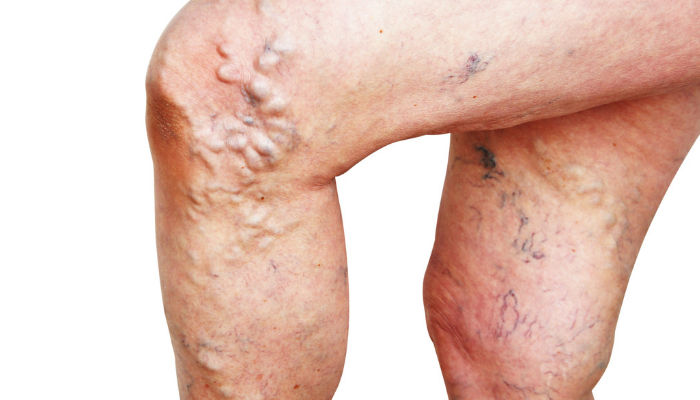Peripheral vascular disease refers to a group of disorders occurring in any part of the blood circulatory system except the brain and the heart. Changes may occur in the blood vessel walls leading to vascular (that is pertaining to the blood vessels) disease.
Varicose veins….in particular
A network of blood vessels comprising of arteries, veins and capillaries carry blood back and forth between the heart and various body parts. Veins contain specialized valves which maintain proper blood flow from various organs towards the heart. A ‘varicose vein’ is caused by a dysfunction in the valves of veins causing overfilling of blood in them. It can occur in any vein of the body but more commonly affect the veins of the legs and feet. These veins appear as dark purple, wavy and are clearly visible through the skin. They may become swollen and painful causing heaviness and discomfort.
Symptoms pertaining to varicose veins
Varicose veins are known to have some specific symptoms. Your legs may feel heavy, painful while standing and you will find relief after lying down. You may experience burning, throbbing or itchy sensation around these veins. These symptoms may be aggravated on sitting or standing for long hours.
In severe cases you may also see ulceration around these veins. Blood clots, bleeding, are some of the long term complications that may develop if you keep varicose veins untreated.
While not all varicose veins are dangerous, they should be evaluated and monitored by a vein specialist to determine the scope of treatment required every step of the way. This helps prevent secondary issues related to varicose veins, which include spontaneous bleeding, blood clots, inflammation, venous ulcers, and more.
Knowing all about varicose veins, the important question which needs to be addressed is… whether or not it is a serious illness?
Untreated and unattended varicose veins can complicate
- Skin Ulcers – Varicose veins can cause swelling, which over time can result in skin changes. When this occurs, skin can become less likely to heal from even minor injuries. This happens because the swollen tissue can limit the flow of nutrients and oxygen to the involved tissue, both of which normally aid the healing process. The constant tension on the tissues can prevent healing as well, creating non-healing ulcers. Reducing the swelling is a key treatment for these non-healing ulcers.
- Leg Swelling – As pressure builds within the veins, fluid from the blood can leak into the surrounding tissues, causing swelling. Signs of swelling can include a tight sensation in your skin, or an impression left in your skin after removing your socks or shoes. In more severe cases, your shoes may not fit and your leg may become very swollen. The skin may even leak a clear or yellowish fluid. These symptoms may improve with leg elevation and special elastic socks called compression stockings. If the swelling persists, it can lead to changes in the skin, such as hardening or a change in skin color.
- Skin Infection – When the tissues are stretched from swelling, this interferes with the body’s natural defense against infection. Bacteria that are normally present on our skin can get into the body, causing a skin infection called cellulitis. The swelling may increase and there will generally be a distinct area of redness and warmth. Medication is needed to treat skin infections. Lessening the swelling can also help the infection resolve.
- Bleeding – There is a larger than normal amount of blood in varicose veins, sitting right below the surface of the skin. If the vein is hit or cut, there can be a significant amount of bleeding, more than you would normally expect. Or, if the skin isn’t broken, there may be distinct bruising. It can also take longer than normal for bleeding to stop if the injury is large.
- Thrombophlebitis – Blood is more likely to clot in a varicose vein. Up to 3% of people with varicose veins will develop blood clots. The area becomes painful, warm to the touch and the vein can become hard.
- Deep Vein Thrombosis – Occasionally, in about 25% of people who develop blood clots in varicose veins, the clots will develop in deeper veins. Deep vein thrombosis is a serious medical condition that requires immediate medical treatment. The leg can be swollen, warm, red and painful. The biggest risk is that part or all of the blood clot may break off and move to the lungs, causing a life threatening condition called pulmonary embolism.
If you are experiencing severe symptoms of varicose veins and want a painless treatment alternative, consult a vascular surgeon in your town.
Dr Abhilash Sandhyala is one of the best vascular surgeons in Hyderabad. He is a well-known specialist for varicose veins. He has successfully treated varicose veins for more than 5,000 patients. He has been performing the EVLT procedure for the past 4 years with great results.
You can visit Flow Vascular clinic at H.No: 2-22-298/2/A, Sree Krishna Diagnostic Center Building, 2nd Floor, Beside Kalamandir, KPHB Main Road, Kukatpally, Hyderabad. You can also book an appointment on https://drabhilash.com/book-an-appointment/ or call on (+91) 99896 49498,99590 33037.

